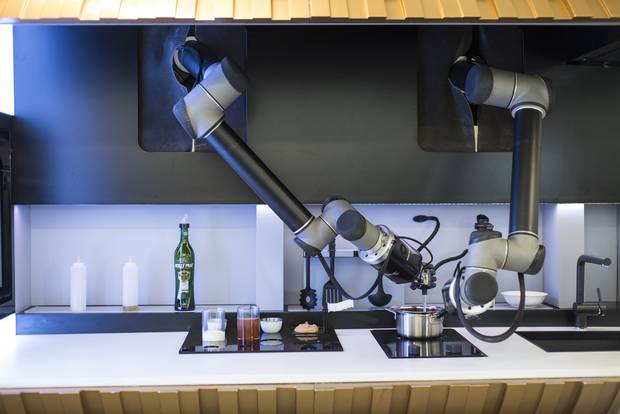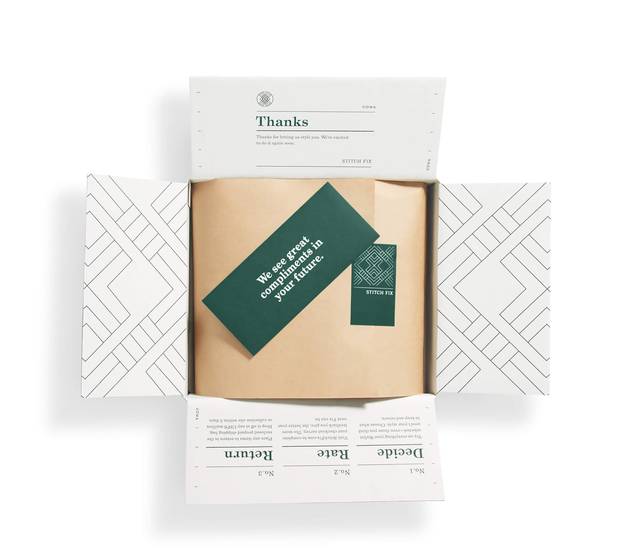An extra set of hands
Calorie counting frying pans and fridges that track freshness are just the beginning of intelligent – and teachable – kitchens

The latest development in artificial intelligence as it relates to food prep is Moley, a robotic chef that can make 100 different meals.
Ralph Whitehead
Forget flying cars. The space age technology the world really needs now is the Jetson family's robot chef, which could spit out Elroy's breakfast at the push of a button while also serving up a bone to the cartoon family's pooch, Astro.
Good news: We're closer than you might think, thanks to a growing interest among techies to apply their smarts to the really important stuff – the creation and consumption of food and drink. There's already plenty of apps, such as Logameal, that promise to transform our lives by evaluating a meal's nutritional value, or Chefling, which will suggest recipes based on the contents of your pantry. Hello Egg, though, a voice-activated kitchen assistant aims to be the first all-in-one culinary sensation of the digital age. It will hit the market this year and, similar to Amazon's Alexa or Apple's Siri, the "Eggspert" will help tailor meals to your tastes and dietary restrictions while keeping track of calories and teaching cooking techniques. Should you be willing to hand over all household management to an artificial intelligence device, Eggspert will even draw up grocery lists and submit them to the market for pickup or delivery.
Eggspert may be smart enough to predict your next favourite dish, but it will never learn how to cook it. For that quantum leap in intelligent kitchen design, there's the Smarty Pan (which keeps track of both frying temperatures and calories) and an Intelligent Oven to ensure you never experience fallen soufflé trauma again. But what extreme kitchen gadget hoarders should really hold out for is Moley, a fully robotic chef with the smarts to make 100 gourmet meals and the ability to learn many more. Due out in 2018, it will cost about the same as an economy car (estimated at $14,000 (U.S.)) and will synch up with a delivery service that can drop off the prepped and pre-portioned ingredients it needs to cook an entire meal. Its designers at Moley Robotics are working on teaching it to do the dishes too but, so far, Moley just fills the sink with soapy water and leaves the dishes to soak.
Those more interested in beer than gourmet meals will be delighted to learn that the world's first "smart beer," IntelligentX, is already on the market in the United Kingdom. IntelligentX, which comes in four different styles, is brewed by Automated Brewing Intelligence (ABI), a system that develops recipes based on algorithms generated with the help of consumer feedback. Beer lovers ping their critiques and suggestions to the company via Facebook and ABI gets to work on inventing new recipes by adding one or more of a thousand "wild card" ingredients. The goal, founder Hew Leith says, isn't to brew by committee and make an all-things-to-all-people type of beer, but rather, to use people's feedback to develop a world-class, award-winning brew.
Of course, you'll want to store that beer in one of the many smart fridges already on the market; so it's easy to keep track of freshness and inventory, and so you have a chance to say, "Close the beer fridge door, HAL." - Christine Sismondo
Made to fit
Collaborations between fashion, beauty and technology pros are creating tools to help shoppers find the perfect fit and shade

Algorithm-designed pieces from Stitch Fix’s subscription shopping service were among the company’s top sellers in 2016.
Using data from clients' preferences and the expertise of in-house stylists, San Francisco-based Stitch Fix allows shoppers to try clothes on through a subscription service, buy the clothes they like and return the rest free of charge, erasing any need for a visit to the nearest mall. In 2016, a pilot project introduced three algorithm-designed pieces to the company's clients. The clothes were among the highest selling products in Stitch Fix's six-year history. The designs are far from boundary defying with basic silhouettes and polka dot or floral patterns, but the design process is, borrowing from the predictive technology that photo-sharing app Instagram uses to recommended profiles to follow.
"A trillion isn't a daunting number to a machine," says Eric Colson, who leads a team of 75 data scientists at Stitch Fix, when he describes how data crunching superiority can lead to sartorial success. "They can try every combination, and based on the data that we've gathered from how each attribute contributes to the overall success of the style, we can recombine clothing in different ways to see if there is some combination that has a good bet of being a winner."
In the beauty world, Toronto-based Modiface has become a favourite of behemoth brands such as Sephora and L'Oreal. In store or on their smartphones, customers use it to digitally experiment with a seemingly infinite loop of products. The platform combines augmented reality (a technology that overlays digital imagery on real word photos and video) with artificial intelligence to detect facial features like eyes, mouths or skin colour. Algorithms are fed data collected by surveying hundreds of faces and the company catalogues preferred colour information to recommend combinations to other users, says Modiface CEO Parham Aarabi.
Slyce, a company founded in Toronto that operates a research and development centre outside Sydney, N.S., powers a visual search function for the apps of retailers including Nordstrom, Neiman Marcus and Tommy Hilfiger. "There are a lot of companies that do image recognition in a lot of different contexts," says Ted Mann, CEO of Slyce. "We're mostly focused on getting people a camera-search experience where they can take a photograph of a product in the retailer's app." Mann says he hopes this will set Slyce apart from its competitors as retailers can use the technology to activate the in-store experience through styling tutorials and help with locating garments of various sizes.
To make all this innovation possible, workers from the fashion and technology industries have had to find common ground for collaboration. "These two seemingly disparate groups of people interact and actually thrive off of each other," says Stitch Fix's Colson. "We actually have an identity crisis. We're both those things mixed together and we're probably better off than being in either one extreme." - Ross Dias
Digital living
While AI is altering the design process, architects and urban planners are focusing on how big data is changing the way we live

A map generated by the Department of Unusual Certainties attempts to chart the physical infrastructure that makes
Torontonians’ digital lives possible.
Artificial intelligence might have once been the stuff of science fiction, but it's arrived in our homes. Service bots that run the gamut from vacuums to care companions and smart technologies that learn and adjust living conditions are already being incorporated into the design of many spaces. AI is growing up quickly, aided by advances in hardware technology and allied fields like biology and neuroscience. The One Hundred Year Study on Artificial Intelligence, a 2016 report by Stanford University, anticipates developments in the next 15 years in transportation, education and the design and management of healthier communities.
Beyond service assistants and consumer products, AI can help solve big social and urban challenges. But are we ready to let it? Newly minted institutions like the Vector Institute for Artificial Intelligence (a collaboration between Ontario's academic institutions and private industry with the support of the Canadian government and $125-million from the Pan-Canadian AI Strategy) and Partnership on AI (founded by tech heavyweights Amazon, Apple, Google, Facebook, IBM and Microsoft) are tackling the ethical and lifestyle implications of the AI boom.
But it's designers who are uniquely positioned to evaluate AI's disruptive effects, says Christopher Pandolfi, a Toronto-based urban designer and educator in interaction design. Quoting Arthur C. Clarke, the science fiction author, who said "any sufficiently advanced technology is indistinguishable from magic," Pandolfi argues that designers should be pulling back the curtain to reveal the realities of a technologically advanced world and addressing issues of privacy and access. To this end, Pandolfi's studio, Department of Unusual Certainties, has led a Jane's Walk to reveal the hidden infrastructure, data centres, cellphone towers and fibre-optic cabling that girds Toronto's digital networks.
But what about AI that actually takes on the task of design? Experimenting with a robots' nascent creativity can produce laughable results. Recently we've seen AI attempt to invent and name new colours by evaluating 7,700 Sherwin Williams paint swatches (they ended up being mostly beige and featured titles like "turdly") and accidently compose moody poetry by gobbling up a literary diet that included 2,865 romance novels (one Google Brain stanza: i want to talk to you./i want to be with you./i don't want to be with you./i don't want to be with you./she didn't want to be with him.)
"One thing that designers and artists have always been good at is to help people imagine what changes will look like and how they'll be part of our daily lives," said Pandolfi. "It doesn't matter if you're an architect, industrial, graphic or service designer. Your job now is to be part of a larger public conversation, shape the 21st century and lead us into the next stage of human existence." - Kristina Ljubanovic
Visit tgam.ca/newsletters to sign up for the Globe Style e-newsletter, your weekly digital guide to the players and trends influencing fashion, design and entertaining, plus shopping tips and inspiration for living well. And follow Globe Style on Instagram @globestyle.
